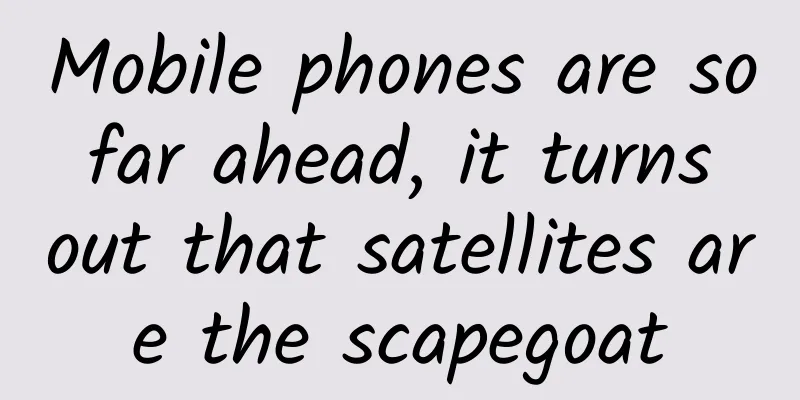Mobile phones are so far ahead, it turns out that satellites are the scapegoat

|
Comes with satellite phone! Ahead of the curve! The latest flagship phone from a famous brand has won the admiration of many consumers. How can you get in touch with a satellite using just a seemingly ordinary mobile phone? Don't you need to carry a "big pot" to transmit weak signals? Today, let's sort out some small knowledge and interesting facts about "satellite phones". Maybe you will use this knowledge next time you change your mobile phone. What exactly is a satellite phone? The so-called "satellite phone" is a means of communication that uses satellites as "base stations". In this article, it specifically refers to satellite mobile communications (the kind that can be carried around). Why use a satellite phone? Aren’t ground base stations better? Usually we think that mobile phones are very easy to use because there are many base stations and good signals in the places where we work and live. In fact, ground base stations are only built in cities, villages and along land transportation routes, but such places only account for 5% of the earth's surface area. Places like oceans, barren mountains, grasslands, deserts, and ice fields are out of reach. Just imagine, where can you find a base station in the vast ocean? In addition, when encountering a major disaster, such as an earthquake or flood, the ground base stations are destroyed on a large scale, which is also where satellite phones come into play. When encountering such a situation where the ground is not working, we might as well look up at the sky and find that there are communication satellites there. China's satellite mobile communication business was officially launched after the 2008 Wenchuan earthquake. Rescue workers use satellite phones in the Sumatra earthquake zone in 2005 Can satellites be guaranteed to always be above our heads? It really can, and it works day and night. There are two secrets: either the satellite is high enough, or there are enough satellites. Because there are two main orbits for communication satellites, one is geostationary orbit and the other is low-Earth orbit. The geostationary orbit satellite is in an orbit 35,786 kilometers above the ground. At this altitude, it orbits the earth once, and the earth also rotates once. From the ground, it appears to be suspended in the air without moving. If it is within the coverage range, it can always be above the head. Satellites in low-Earth orbit are only about 600 to 1,200 kilometers above the ground. At this altitude, they must run very fast to avoid falling. Therefore, low-Earth orbit satellites will not stay in the same place in the sky. In order to ensure uninterrupted communication, many low-Earth orbit satellites must be launched to ensure that satellite phones can always "see" a few. What is the difference between these two tracks? The two types of orbits have their own advantages and disadvantages. The advantage of geostationary orbit satellites is that they save money. In theory, only three satellites need to be launched to cover all places on the earth except the polar regions (in fact, a few more satellites will be launched as backup). Satellite communication business can start from here. However, geostationary satellites are too far from the Earth, and the signal takes at least 0.24 seconds to go back and forth. In addition, because they only orbit above the equator, they cannot cover the North and South Poles, where scientific researchers often go and need satellite phones. Also, for Chinese users, geostationary satellites are in the southern sky, so it is difficult to connect to the shaded side of buildings or steep mountains. Low Earth Orbit satellites are just the opposite. They are close to the Earth, have short signal delays, good signal quality, can cover the polar regions, and are not too demanding in terms of orientation. However, they require dozens of satellites to cover the entire globe, which drives up costs. For example, the first generation of Iridium at the end of the last century planned to launch 77 satellites (so it was named "Iridium" after the 77th element) to cover the entire globe, but Iridium went bankrupt soon after, which was largely due to "overdoing it" in this regard. Is the satellite phone signal good? Will it consume a lot of battery? If a communications satellite looks like a mobile base station in a residential area, the signal would certainly not be good. If we want to contact such a satellite from the ground, we have to carry a large antenna with us, which is both energy-consuming and labor-intensive. Fortunately, communication satellites do not look like cell phone base stations. In order to keep us living peacefully, satellites resolutely carry the burden and become scapegoats, literally! The huge antenna of the Tiantong-1 satellite Take China's Tiantong-1 communications satellite as an example. It is in geostationary orbit, very far from the ground. In order to capture the faint signals coming from 35,786 kilometers away, it carries a big pot - a mesh antenna with a diameter of 15 meters. With the satellite's receiving sensitivity and transmission strength improved, ground equipment can basically maintain the appearance of a smartphone. Some domestic smartphones have integrated satellite phone functions, and the ones connected to the network are Tiantong-1. Can satellite phones access the Internet? If you are connecting to a low-Earth orbit satellite, you can use the satellite to access the Internet. Musk's Starlink project is to do this, but it is impossible for a smartphone to connect directly to a satellite. It requires an antenna that looks quite inconvenient. If it is connected to a geostationary satellite, the Internet speed will be worrying, which is equivalent to returning to the era of telephone dial-up with dozens of k per second. What's more, Tiantong-1 has not yet opened Internet access services. Therefore, up to now, whether using domestic or foreign satellites, the essence of smartphones integrated with satellite phones is just "no need to carry two phones", and in terms of function, only the call part is combined. Let's just use satellite phones as wilderness survival tools and wait for technological development! Can I use a satellite phone on an airplane? In fact, some foreign airlines have already provided satellite phones long before they became popular among the public. On some planes, there is a phone on the back of the front seat with a credit card slot on it. In fact, it is a satellite phone. Airlines like you to make this kind of call, but it is too expensive. However, its antenna is on top of the plane and is part of the aircraft itself, so it does not cause any problems. Various antennas on the Boeing 777 fuselage, including SATCOM for satellite communications from the aircraft technical data As for using a personal satellite phone on an airplane, this is a matter of legal and technical aspects. Legally, no, not as long as there is a risk of interfering with aviation communications. Technically, it is difficult to get through. We are far away from the satellite, so the satellite and the terminal need to communicate "face to face" to achieve the best effect. It is more convenient to talk in open and spacious places. If you go indoors or there are buildings or steep mountains blocking the direction of the satellite, the signal will not be very good. Like in "Jurassic Park 3", the satellite phone can still ring even when it is buried deep in a pile of dinosaur feces. That is the artistic processing of the screenwriter. Our Tiantong-1 operates above the equator. For all Chinese users, it is in the southern sky, which has high requirements for the direction of the passengers covered in the metal shell of the aircraft. The picture is taken from a short video of Weibo user Xiyu Daoke's Independent View Someone recently made a satellite phone call on an airplane. Someone else has verified that it is possible to make a satellite call if you are near a south-facing window and can see a hint of satellite signal, but it is not possible if you sit a little deeper or change direction. However, I want to repeat it here: it is understandable to want to show off your new phone, but it is really against the rules to make a satellite call on an airplane! Please don't do this. Planning and production Author: Qu Jiong Popular Science Writer Review丨Lin Siyu, Associate Professor, School of Electronic Information Engineering, Beijing Jiaotong University Planning丨Ding Zong Editor: Ding Zong |
<<: Why do unoccupied houses age so quickly?
Recommend
The late spring cold has gone and the south wind has returned. What should we do with such bad weather?
After enduring the late spring cold in the north,...
Is Youqianhua loan reliable? How about it?
How about a Youqianhua loan? Is it reliable? Amon...
It's a cold dish, but it's a good one. Trails in the Sky FC Evolution: Try it before you buy it
As an excellent work on PSV that has received rav...
If you overuse your brain, will it become "overloaded" like an electrical appliance?
At the end of December, it is the "exam seas...
Aurora erupts in Beijing, and there may be more tomorrow morning! Why does this astronomical wonder happen?
In the early morning of October 11, affected by t...
Five elements of user reach: materials, channels, and objects!
My definition of user reach is: sending specific ...
Advertising design industry improvement video course
Introduction to video course resources for improv...
The Ministry of Industry and Information Technology released 136 apps that violated user rights: Tencent Mobile Manager was among them
On March 12, the Ministry of Industry and Informa...
A complete method for event operation!
Let me talk about my views on event operations . ...
What should you do to stay safe when you encounter wild animals?
Mixed Knowledge Specially designed to cure confus...
How to write a planning proposal clearly and logically?
Many of my friends and colleagues have told me th...
Hacker secret war: the secret world behind black hat, white hat and gray hat
[[120968]] QQ numbers, credit card passwords, cor...
#千万IP创科普# Pointing at the moon will result in your ears being cut off? The truth is...
Have you ever had your ears cut off by the moon? ...
Why are girls’ abdominal muscles called vest lines?
What Dongdong Miao envies most is people with abd...
Data operation: How to use data analysis to achieve user growth?
What does data analytics mean for growth? How to ...









